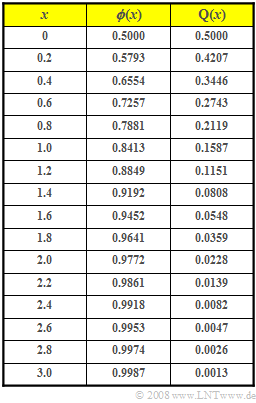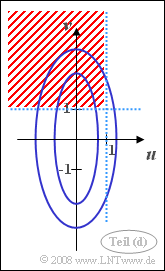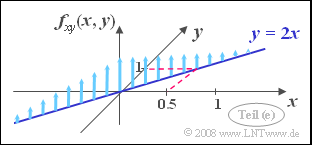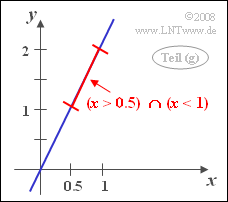Difference between revisions of "Aufgaben:Exercise 4.4: Two-dimensional Gaussian PDF"
| Line 1: | Line 1: | ||
| − | {{quiz-Header|Buchseite=Theory_of_Stochastic_Signals/Two- | + | {{quiz-Header|Buchseite=Theory_of_Stochastic_Signals/Two-Dimensional_Gaussian_Random_Variables |
}} | }} | ||
| Line 31: | Line 31: | ||
| − | === | + | ===Questions=== |
<quiz display=simple> | <quiz display=simple> | ||
| − | { | + | {Which of the statements are true with respect to 2D random variable $(u, v)$ ? |
|type="[]"} | |type="[]"} | ||
| − | + | + | + The random variables $u$ and $v$ are uncorrelated. |
| − | + | + | + The random variables $u$ and $v$ are statistically independent. |
| − | { | + | {Calculate the two standard deviations $\sigma_u$ and $\sigma_v$. Enter the quotient of the two standard deviations as a check. |
|type="{}"} | |type="{}"} | ||
$\sigma_u/\sigma_v \ = \ $ { 0.5 3% } | $\sigma_u/\sigma_v \ = \ $ { 0.5 3% } | ||
| − | { | + | {Calculate the probability that $u$ is less than $1$ . |
|type="{}"} | |type="{}"} | ||
| − | ${\rm Pr}(u < 1)\ = | + | ${\rm Pr}(u < 1)\ = \ $ { 0.9772 3% } |
| − | { | + | {Calculate the probability that the random variable $u$ is less than $1$ and at the same time the random variable $v$ is greater than $1$ . |
|type="{}"} | |type="{}"} | ||
| − | ${\rm Pr}\big[(u < 1) ∩ (υ > 1)\big]\ = | + | ${\rm Pr}\big[(u < 1) ∩ (υ > 1)\big]\ = \ $ { 0.1551 3% } |
| − | { | + | {Which of the statements are true for the 2D–random variable $(x, y)$ ? |
|type="[]"} | |type="[]"} | ||
| − | + | + | + The 2D PDF $f_{xy}(x, y)$ is always zero outside the straight line $y = 2x$ . |
| − | - | + | - For all pairs of values on the straight line $y = 2x$ $f_{xy}(x, y)= 0.5$. |
| − | + | + | + With respect to the edge PDF, $f_{x}(x) = f_{u}(u)$ and $f_{y}(y) = f_{v}(v)$ holds. |
| − | { | + | {Calculate the probability that $x$ is less than $1$ . |
|type="{}"} | |type="{}"} | ||
| − | ${\rm Pr}(x < 1)\ = | + | ${\rm Pr}(x < 1)\ = \ $ { 0.9772 3% } |
| − | { | + | {Now calculate the probability that the random variable $x$ is smaller than $1$ and at the same time the random variable $y$ is larger than $1$ . |
|type="{}"} | |type="{}"} | ||
| − | ${\rm Pr}\big[(x < 1) ∩ (y > 1)\big]\ = \ $ | + | ${\rm Pr}\big[(x < 1) ∩ (y > 1)\big]\ = \ $ { 0.1359 3% } |
| Line 75: | Line 75: | ||
</quiz> | </quiz> | ||
| − | === | + | ===Solution=== |
{{ML-Kopf}} | {{ML-Kopf}} | ||
| − | '''(1)''' <u> | + | '''(1)''' <u>Both statements are true</u>: |
| − | * | + | *Comparing the given 2D PDF with the general 2D PDF. |
| − | + | $$f_{uv}(u,v) = \frac{\rm 1}{{\rm 2}\it\pi \cdot \sigma_u \cdot \sigma_v \cdot \sqrt{{\rm 1}-\it \rho_{\it uv}^{\rm 2}}} \cdot \rm exp\left[\frac{\rm 1}{2\cdot (\rm 1-\it \rho_{uv}^{\rm 2}{\rm )}}(\frac{\it u^{\rm 2}}{\it\sigma_u^{\rm 2}} + \frac{\it v^{\rm 2}}{\it\sigma_v^{\rm 2}} - \rm 2\it\rho_{uv}\frac{\it u\cdot \it v}{\sigma_u\cdot \sigma_v}\rm )\right],$$ | |
| − | :so | + | :so it can be seen that no term with $u \cdot v$ occurs in the exponent, which is only possible with $\rho_{uv} = 0$ mögible. |
| − | * | + | *But this means that $u$ and $v$ are uncorrelated. |
| − | * | + | *For Gaussian random variables, however, statistical independence always follows from uncorrelatedness. |
| − | '''(2)''' | + | '''(2)''' With statistical independence holds: |
:$$f_{uv}(u, v) = f_u(u)\cdot f_v(v), \hspace{0.5cm} | :$$f_{uv}(u, v) = f_u(u)\cdot f_v(v), \hspace{0.5cm} | ||
f_u(u)=\frac{{\rm e}^{-{\it u^{\rm 2}}/{(2\sigma_u^{\rm 2})}}}{\sqrt{\rm 2\pi}\cdot\sigma_u} , \hspace{0.5cm} \it f_v{\rm (}v{\rm )}=\frac{{\rm e}^{-{\it v^{\rm 2}}/{{\rm (}{\rm 2}\sigma_v^{\rm 2}{\rm )}}}}{\sqrt{\rm 2\pi}\cdot\sigma_v}.$$ | f_u(u)=\frac{{\rm e}^{-{\it u^{\rm 2}}/{(2\sigma_u^{\rm 2})}}}{\sqrt{\rm 2\pi}\cdot\sigma_u} , \hspace{0.5cm} \it f_v{\rm (}v{\rm )}=\frac{{\rm e}^{-{\it v^{\rm 2}}/{{\rm (}{\rm 2}\sigma_v^{\rm 2}{\rm )}}}}{\sqrt{\rm 2\pi}\cdot\sigma_v}.$$ | ||
| − | * | + | *By comparing coefficients, we get $\sigma_u = 0.5$ and $\sigma_v = 1$. |
| − | * | + | *The quotient is thus $\sigma_u/\sigma_v\hspace{0.15cm}\underline{=0.5}$. |
| − | [[File:P_ID265__Sto_A_4_4_d.png|right|frame| | + | [[File:P_ID265__Sto_A_4_4_d.png|right|frame|Probability: $\rm Pr\big[(\it u < \rm 1) \cap (\it v > \rm 1)\big]$]] |
| − | '''(3)''' | + | '''(3)''' Since $u$ is a continuous random variable, holds: |
:$$\rm Pr(\it u < \rm 1) = \rm Pr(\it u \le \rm 1) =\it F_u\rm (1). $$ | :$$\rm Pr(\it u < \rm 1) = \rm Pr(\it u \le \rm 1) =\it F_u\rm (1). $$ | ||
| − | * | + | *With the mean $m_u = 0$ and the standard deviation $\sigma_u = 0.5$ we get: |
:$$\rm Pr(\it u < \rm 1) = \rm \phi({\rm 1}/{\it\sigma_u})= \rm \phi(\rm 2) \hspace{0.15cm}\underline{=\rm 0.9772}. $$ | :$$\rm Pr(\it u < \rm 1) = \rm \phi({\rm 1}/{\it\sigma_u})= \rm \phi(\rm 2) \hspace{0.15cm}\underline{=\rm 0.9772}. $$ | ||
| − | '''(4)''' | + | '''(4)''' Due to the statistical independence between $u$ and $v$ holds: |
:$$\rm Pr\big[(\it u < \rm 1) \cap (\it v > \rm 1)\big] = \rm Pr(\it u < \rm 1)\cdot \rm Pr(\it v > \rm 1).$$ | :$$\rm Pr\big[(\it u < \rm 1) \cap (\it v > \rm 1)\big] = \rm Pr(\it u < \rm 1)\cdot \rm Pr(\it v > \rm 1).$$ | ||
| − | * | + | *The probability ${\rm Pr}(u < 1) =0.9772$ has already been calculated. |
| − | * | + | *For the second probability ${\rm Pr}(v > 1)$ holds for reasons of symmetry: |
:$$\rm Pr(\it v > \rm 1) = \rm Pr(\it v \le \rm (-1) = \it F_v\rm (-1) = \rm \phi(\frac{\rm -1}{\it\sigma_v}) = \rm Q(1) =0.1587$$ | :$$\rm Pr(\it v > \rm 1) = \rm Pr(\it v \le \rm (-1) = \it F_v\rm (-1) = \rm \phi(\frac{\rm -1}{\it\sigma_v}) = \rm Q(1) =0.1587$$ | ||
:$$\Rightarrow \hspace{0.3cm} \rm Pr\big[(\it u < \rm 1) \cap (\it v > \rm 1)\big] = \rm 0.9772\cdot \rm 0.1587 \hspace{0.15cm}\underline{ = \rm 0.1551}.$$ | :$$\Rightarrow \hspace{0.3cm} \rm Pr\big[(\it u < \rm 1) \cap (\it v > \rm 1)\big] = \rm 0.9772\cdot \rm 0.1587 \hspace{0.15cm}\underline{ = \rm 0.1551}.$$ | ||
| − | + | The sketch illustrates the given constellation: | |
| − | * | + | *The PDF (blue) height lines are stretched ellipses due to $\sigma_v > \sigma_u$ in vertical direction. |
| − | * | + | *Drawn in red shading is the area whose probability should be calculated in this subtask. |
| − | [[File:P_ID266__Sto_A_4_4_e.png|right|frame|2D | + | [[File:P_ID266__Sto_A_4_4_e.png|right|frame|2D Dirac "wall" on the correlation line]] |
| − | '''(5)''' | + | '''(5)''' Correct are <u>the first and the third suggested solutions</u>: |
| − | * | + | *Because $\rho_{xy} = 1$ there is a deterministic correlation between $x$ and $y$ |
| − | :⇒ | + | :⇒ All values lie on the straight line $y =K(x) \cdot x$. |
| − | * | + | *Because of the standard deviations $\sigma_x = 0.5$ and $\sigma_y = 1$ it holds $K = 2$. |
| − | * | + | *On this straight line $y = 2x$ all PDF values are infinitely large. |
| − | * | + | *This means: The 2D PDF is here a "Dirac wall". |
| − | * | + | *As you can see from the sketch, the PDF values are distributed evenly on the straight line $y = 2x$ . |
| − | * | + | *The straight line $y = 2x$ also represents the correlation line. |
| − | * | + | *The two marginal probability densities are also Gaussian functions, each with zero mean. |
| − | * | + | *Because $\sigma_x = \sigma_u$ and $\sigma_y = \sigma_v$ also holds: |
| − | :$$f_x(x) = f_u(u), | + | :$$f_x(x) = f_u(u), \hspace{0.5cm}f_y(y) = f_v(v).$$ |
| − | [[File:P_ID274__Sto_A_4_4_g.png|right|frame| | + | [[File:P_ID274__Sto_A_4_4_g.png|right|frame|Probability calculation for the Dirac wall]] |
| − | '''(6)''' | + | '''(6)''' Since the PDF of the random variable isö&aerospace;e $x$ identical to the PDF $f_u(u)$, it also results in exactly the same probability as calculated in the subtask '''(3)''' : |
:$$\rm Pr(\it x < \rm 1) \hspace{0.15cm}\underline{ = \rm 0.9772}.$$ | :$$\rm Pr(\it x < \rm 1) \hspace{0.15cm}\underline{ = \rm 0.9772}.$$ | ||
| − | '''(7)''' | + | '''(7)''' The random event $y > 1$ is identical to the event $x > 0.5$. |
| − | * | + | *Thus, the wanted probability is equal to. |
:$$\rm Pr \big[(\it x > \rm 0.5) \cap (\it x < \rm 1)\big] = \it F_x \rm( 1) - \it F_x\rm (0.5). $$ | :$$\rm Pr \big[(\it x > \rm 0.5) \cap (\it x < \rm 1)\big] = \it F_x \rm( 1) - \it F_x\rm (0.5). $$ | ||
| − | * | + | *With the standard deviation $\sigma_x = 0.5$ follows further: |
:$$\rm Pr \big[(\it x > \rm 0.5) \cap (\it x < \rm 1)\big] = \rm \phi(\rm 2) - \phi(1)=\rm 0.9772- \rm 0.8413\hspace{0.15cm}\underline{=\rm 0.1359}.$$ | :$$\rm Pr \big[(\it x > \rm 0.5) \cap (\it x < \rm 1)\big] = \rm \phi(\rm 2) - \phi(1)=\rm 0.9772- \rm 0.8413\hspace{0.15cm}\underline{=\rm 0.1359}.$$ | ||
| − | |||
{{ML-Fuß}} | {{ML-Fuß}} | ||
Revision as of 23:20, 23 January 2022
We consider two-dimensional random variables, where both components are always assumed to be mean-free.
- The 2D PDF of the random variable $(u, v)$ is:
- $$f_{uv}(u, v)={1}/{\pi} \cdot {\rm e}^{-(2u^{\rm 2} \hspace{0.05cm}+ \hspace{0.05cm}v^{\rm 2}\hspace{-0.05cm}/\rm 2)}.$$
- The following parameters are known from the 2D random variable $(x, y)$ which is also Gaussian:
- $$\sigma_x= 0.5, \hspace{0.5cm}\sigma_y = 1,\hspace{0.5cm}\rho_{xy} = 1. $$
The values of the Gaussian error integral ${\rm \phi}(x)$ and the complementary function ${\rm Q}(x) = 1- {\rm \phi}(x)$ can be found in the adjacent table.
Hints:
- The exercise belongs to the chapter Two-dimensional Gaussian Random Variables.
- Reference is also made to the chapter Gaussian distributed random variables
- More information on this topic is provided in the learning video Gaussian 2D random variables:
- Part 1: Gaussian random variables without statistical bindings,
- Part 2: Gaussian random variables with statistical bindings.
Questions
Solution
- Comparing the given 2D PDF with the general 2D PDF.
$$f_{uv}(u,v) = \frac{\rm 1}{{\rm 2}\it\pi \cdot \sigma_u \cdot \sigma_v \cdot \sqrt{{\rm 1}-\it \rho_{\it uv}^{\rm 2}}} \cdot \rm exp\left[\frac{\rm 1}{2\cdot (\rm 1-\it \rho_{uv}^{\rm 2}{\rm )}}(\frac{\it u^{\rm 2}}{\it\sigma_u^{\rm 2}} + \frac{\it v^{\rm 2}}{\it\sigma_v^{\rm 2}} - \rm 2\it\rho_{uv}\frac{\it u\cdot \it v}{\sigma_u\cdot \sigma_v}\rm )\right],$$
- so it can be seen that no term with $u \cdot v$ occurs in the exponent, which is only possible with $\rho_{uv} = 0$ mögible.
- But this means that $u$ and $v$ are uncorrelated.
- For Gaussian random variables, however, statistical independence always follows from uncorrelatedness.
(2) With statistical independence holds:
- $$f_{uv}(u, v) = f_u(u)\cdot f_v(v), \hspace{0.5cm} f_u(u)=\frac{{\rm e}^{-{\it u^{\rm 2}}/{(2\sigma_u^{\rm 2})}}}{\sqrt{\rm 2\pi}\cdot\sigma_u} , \hspace{0.5cm} \it f_v{\rm (}v{\rm )}=\frac{{\rm e}^{-{\it v^{\rm 2}}/{{\rm (}{\rm 2}\sigma_v^{\rm 2}{\rm )}}}}{\sqrt{\rm 2\pi}\cdot\sigma_v}.$$
- By comparing coefficients, we get $\sigma_u = 0.5$ and $\sigma_v = 1$.
- The quotient is thus $\sigma_u/\sigma_v\hspace{0.15cm}\underline{=0.5}$.
(3) Since $u$ is a continuous random variable, holds:
- $$\rm Pr(\it u < \rm 1) = \rm Pr(\it u \le \rm 1) =\it F_u\rm (1). $$
- With the mean $m_u = 0$ and the standard deviation $\sigma_u = 0.5$ we get:
- $$\rm Pr(\it u < \rm 1) = \rm \phi({\rm 1}/{\it\sigma_u})= \rm \phi(\rm 2) \hspace{0.15cm}\underline{=\rm 0.9772}. $$
(4) Due to the statistical independence between $u$ and $v$ holds:
- $$\rm Pr\big[(\it u < \rm 1) \cap (\it v > \rm 1)\big] = \rm Pr(\it u < \rm 1)\cdot \rm Pr(\it v > \rm 1).$$
- The probability ${\rm Pr}(u < 1) =0.9772$ has already been calculated.
- For the second probability ${\rm Pr}(v > 1)$ holds for reasons of symmetry:
- $$\rm Pr(\it v > \rm 1) = \rm Pr(\it v \le \rm (-1) = \it F_v\rm (-1) = \rm \phi(\frac{\rm -1}{\it\sigma_v}) = \rm Q(1) =0.1587$$
- $$\Rightarrow \hspace{0.3cm} \rm Pr\big[(\it u < \rm 1) \cap (\it v > \rm 1)\big] = \rm 0.9772\cdot \rm 0.1587 \hspace{0.15cm}\underline{ = \rm 0.1551}.$$
The sketch illustrates the given constellation:
- The PDF (blue) height lines are stretched ellipses due to $\sigma_v > \sigma_u$ in vertical direction.
- Drawn in red shading is the area whose probability should be calculated in this subtask.
(5) Correct are the first and the third suggested solutions:
- Because $\rho_{xy} = 1$ there is a deterministic correlation between $x$ and $y$
- ⇒ All values lie on the straight line $y =K(x) \cdot x$.
- Because of the standard deviations $\sigma_x = 0.5$ and $\sigma_y = 1$ it holds $K = 2$.
- On this straight line $y = 2x$ all PDF values are infinitely large.
- This means: The 2D PDF is here a "Dirac wall".
- As you can see from the sketch, the PDF values are distributed evenly on the straight line $y = 2x$ .
- The straight line $y = 2x$ also represents the correlation line.
- The two marginal probability densities are also Gaussian functions, each with zero mean.
- Because $\sigma_x = \sigma_u$ and $\sigma_y = \sigma_v$ also holds:
- $$f_x(x) = f_u(u), \hspace{0.5cm}f_y(y) = f_v(v).$$
(6) Since the PDF of the random variable isö&aerospace;e $x$ identical to the PDF $f_u(u)$, it also results in exactly the same probability as calculated in the subtask (3) :
- $$\rm Pr(\it x < \rm 1) \hspace{0.15cm}\underline{ = \rm 0.9772}.$$
(7) The random event $y > 1$ is identical to the event $x > 0.5$.
- Thus, the wanted probability is equal to.
- $$\rm Pr \big[(\it x > \rm 0.5) \cap (\it x < \rm 1)\big] = \it F_x \rm( 1) - \it F_x\rm (0.5). $$
- With the standard deviation $\sigma_x = 0.5$ follows further:
- $$\rm Pr \big[(\it x > \rm 0.5) \cap (\it x < \rm 1)\big] = \rm \phi(\rm 2) - \phi(1)=\rm 0.9772- \rm 0.8413\hspace{0.15cm}\underline{=\rm 0.1359}.$$



